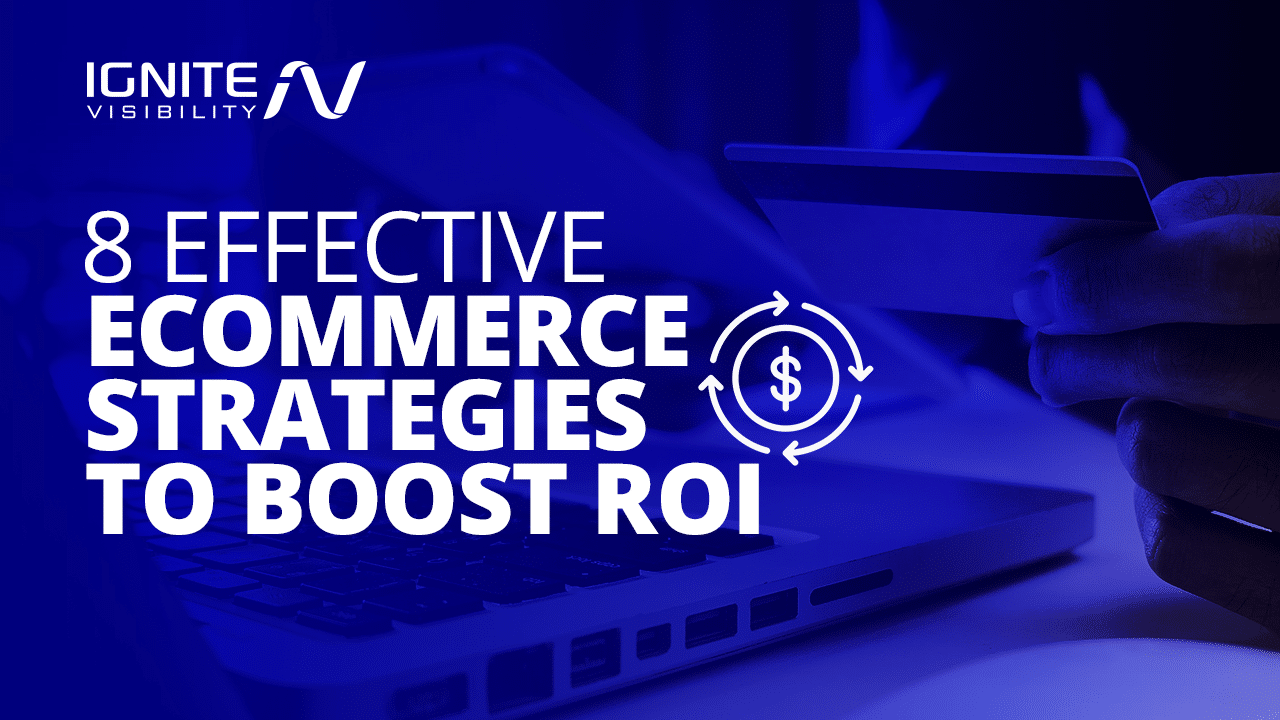
What We’ll Cover:
What is Ecommerce ROI?
One of the biggest indicators of success for ecommerce strategies is return on investment (ROI). Ecommerce ROI measures the total income that you’ve earned with your investments in online marketing and advertising.
Measuring Ecommerce ROI
You can use the following formula to measure ecommerce ROI: (Profit – Investment) / Investment X 100 = ROI
An example of this would be if you made $20,000 after investing $5,000, in which case you would subtract $5,000 from the $20,000 to give you $15,000. You would then divide that number by the $5,000 investment and then multiply that total by 100, which will give you an ROI of 300%, which is a significant figure.
The key to boosting ecommerce ROI is to optimize your marketing and advertising to make the most of your budget and to track some of the key performance indicators (KPIs) that help you measure ROI.
KPIs to Track for Ecommerce ROI
A few of the most helpful KPIs to track to gauge ecommerce success include:
- Total income
- Total number of customers
- Total number of sales/orders
You can keep track of and measure these metrics using Google Analytics and other platforms as you develop and optimize your marketing strategies.
To build the perfect ecommerce strategy and increase ROI for ecommerce marketing and advertising, implement the following strategies.
8 Ecommerce Strategies to Boost ROI
Ready to get better results from your ecommerce marketing campaigns? Review these 8 ecommerce strategies in this guide.
Ecommerce Strategy #1: Get the Customer to Invest with a Personalized Message
Personalization is pretty quickly becoming the new standard in online marketing.
We’ve seen it in email marketing for some time now, in the form of messaging based on website behavior and specific interests and topics.
But did you know personalization can be used to boost ecommerce ROI as well? In fact, 89% of marketers see a positive ROI when using personalization in their efforts.
Even if you’re not consciously aware of it, you’ve probably seen it in action.
Take big guns like Amazon and Netflix.
You know how every time you go to a product page on Amazon, it recommends items that are commonly purchased together? That’s ecommerce personalization.
Or on Netflix, how one of its major categories is “Recommended for you?”
That’s personalization in action as well, and it works because it shows people things they would like but are unlikely to find all on their own.
But there’s a lot you can do with personalization beyond product recommendations. Think tailored live chats or location-specific offers.
One example comes from Bones Coffee Company, which sends personalized SMS text offers to customers, addressing the customer by name with a limited offer:
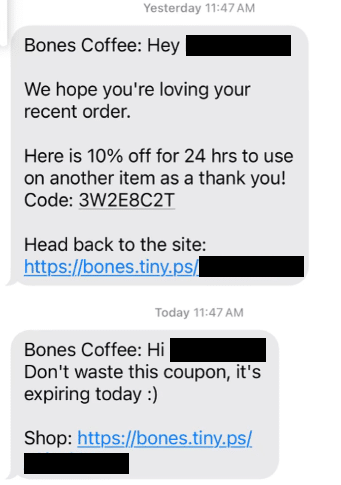
Personalized SMS Text Offer
Messages like these can get people’s attention while encouraging them to make a repeat purchase soon after their initial order.
One new tool that can further help with personalization is AI, which can collect and assess large quantities of behavioral data and other data from your customers.
AI can then help you use this information from people’s buying and browsing habits to cater interactions to them, whether through social media, your website, or other channels.
For example, AI can help you either repurpose existing content or create new content with personalized elements to target specific audiences. In turn, you can automate personalization and scale it more easily.
Ecommerce Strategy #2: Do an Influencer Outreach Campaign
Another (not so secret) ecommerce strategy? Influencer marketing.
Influencers are the latest internet sensations, and their power over followers is undeniable:
- 49% of people say they rely on recommendations from influencers when making purchase decisions.
- 49% of people say they’ve purchased an item online after seeing it used by an influencer.
- Additionally, 67% of marketers in a survey stated that they would increase their influencer marketing budget in 2023.
- Over 80% of people are also beginning to understand how influencer marketing brings in high-quality customers that subsequently help with boosting ecommerce ROI.
Here’s how you find them.
First, if you don’t have one already, set up an account in BuzzSumo (they offer free trial period).
Once in, type a keyword related to your products or services into the search bar.
For example, let’s type in “shoes.”
Select the Influencer tab from the top menu. This will show you a list of all the top influencers in the shoe niche.

Ecommerce strategy: Find influencers on BuzzSumo
From the list that’s generated, you want to choose a list of 20-100 influencers.
So take a look at the top Influencers BuzzSumo pulled – Nike and FootLocker. Both have millions of followers, which makes it pretty unlikely that they’ll respond to your brand.
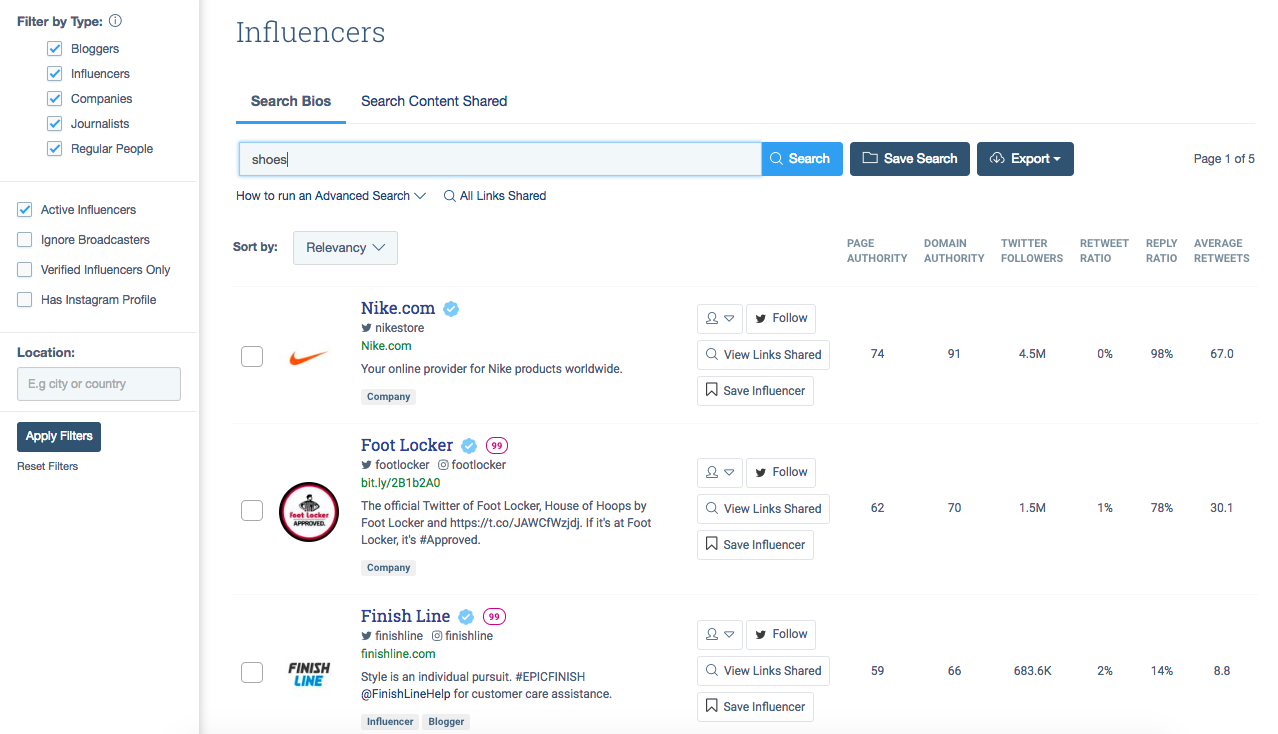
Ecommerce strategy: Influencer marketing
So let’s refine our search to better fit into our ecommerce strategy.
Over in the left-hand sidebar, you’ll see options to narrow your search down to Bloggers, Journalists, Regular People, etc. Play with the different options until you’ve generated a solid list of influencers that may be applicable to your brand.
Once you have your list, put together a small package that includes a free sample of your product and a one-sheet that introduces your company.
Your one-sheet should look something like this:

Ecommerce strategy: Run an influencer outreach campaign
Make it short and sweet, while addressing the fact that you know and appreciate their work, introduces your product, and asks for a social share.
Your goal here? To get 40% of influencers to post about your product.
Then, you can use those posts as social proof.
The breakdown will look something like this:
- 40% of influencers will do a post about your product (40 out of 100 you send your package to)
- 50% of each influencer’s followers will see that post (so if the influencer has 10,000 followers, 5,000 will see the post)
- CTR of followers is 20%
- Conversion rate: 5%
- Revenue: 1 product sold
So say you have a product that costs $100. If you send 10 products and each influencer has around 10,000 followers, your revenue from this campaign would be $200,000.
Not too shabby, right? That’s how you use influencers to boost your ecommerce ROI.
Ecommerce Strategy #3: Media Buy Blitz
Want to get into media buying and sponsored posts? The following are some of the most popular media buying platforms available:
- Advidi — This affiliate marketing network offers access to advertisers and publishers all over the world. Apart from global reach, this platform’s ability to help you take advantage of many oft-banned verticals like sweepstakes makes it stand out.
- Google Display & Video 360 — This platform, DV360 for short, works with Google products like Google Analytics for easy integration. Using DV360, you can get access to some of the top publishers, with added features such as hyper-targeting and automated bidding that really help with media buying.
- AdColony — Want to connect with people using mobile devices? AdColony is here to help with ad placements and video advertising on Android and iOS devices.
These are merely a few of the many media buying platforms available to help boost ecommerce ROI through sponsored posts and other media buys.
Ecommerce Strategy #4: Launch a Targeted Ad Campaign
Advertising should be part of any ecommerce strategy or campaign.
Which means that hopefully, you’re already familiar with and using ads to push your products.
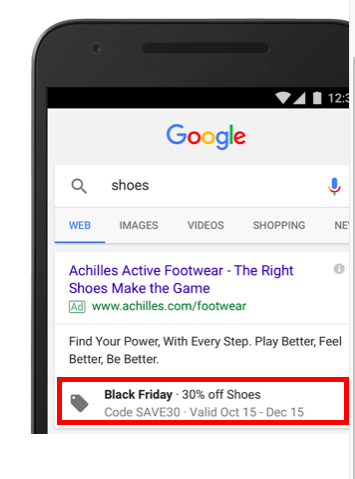
Ecommerce strategy: use promotion extensions
But what I’m talking about here is using some of Google Ads’s newest features to launch your new ecommerce campaigns.
Those new features include the following:
Google Ads Extensions
One type of feature to use for developing a targeted ecommerce marketing strategy is Google Ads Extensions, which can include the following:
- Promotion Extensions – Use this to highlight any special promotions you’re running in your Google Ads advertisment
- Message Extensions – This allows users to text you straight from an ad; giving them the option to text increases the odds that they will interact with your business
- Price Extensions – Pre-qualify users by displaying your product’s price in your ad. If it’s out of their price range, they won’t click the ad.
- App Extension – If you have an app available, the app extension will encourage users to download it.
Life Event Targeting
Life event targeting allows you to run ads to users who are going through major life changes, rather than the typical demographics or interest targeting, which can be extremely beneficial in an ecommerce strategy.
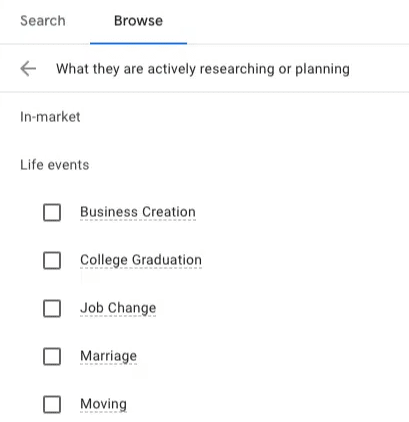
Life Event Targeting
As of now, Google Ads lets you target your audience by the following live events:
- About to graduate college
- Recently graduated college
- About to move
- Recently moved
- About to get married
- Recently got married
This is an incredibly effective option for anyone who sells a product that aligns with any of the above events.
So, if you sell furniture, targeting to those who are about to or have recently moved would be a great way to get your product in front of an interested, qualified audience.
To drill down even further, you can layer other targeting options on top of the life event to further target by age, marital status, income level, location, etc.
Interest & Intent Targeting
Another new feature you’ll want to try in your ecommerce strategy is In-Market Audiences.
This is a way to target prospects that have shown interest in a product you’re selling based on their browsing behavior.
So, if you sell televisions, you could target users who have recently been browsing TV’s on various sites across the web.
This is a way to target people who are already towards the top of the sales funnel, and therefore have a much higher chance of actually making a purchase.
With all of these different ad options available for your ecommerce strategy, businesses are now able to target users at all stages of the buying cycle by interest, intent, and action.
- Interest targeting:
- Affinities
- Consumer Patterns
- In-Market Behavior
- Life Events
- Intent Targeting:
- Custom Intent (this one lets you bring your search keyword list to YouTube and reach users who have searched for those keywords before. It’s brand new, and Ignite has access to it because we’re a Google Premier Partner.)
- Action Targeting:
- Remarketing
- Custom Match
- Similar Audiences
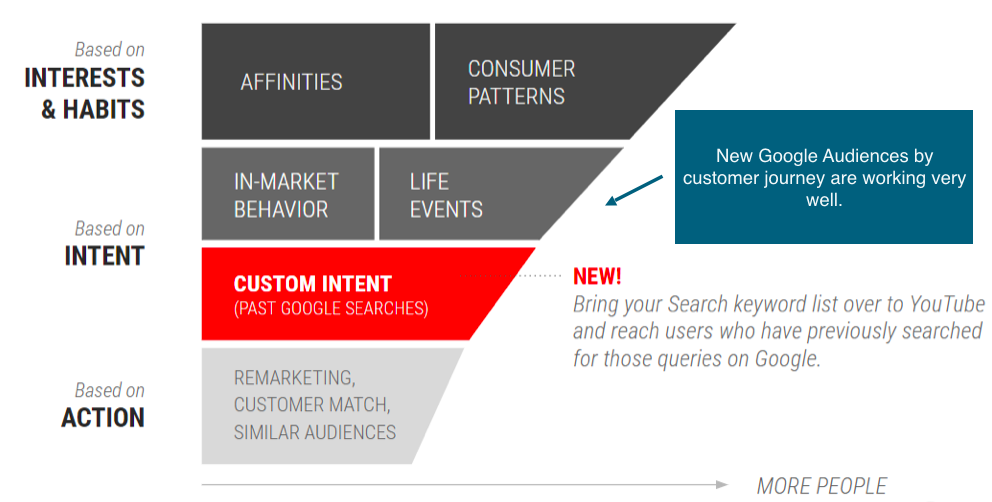
Ecommerce strategy: run targeted ads
But your ecommerce strategy ad options aren’t limited to Google Ads.
Facebook is another channel you should be using to increase your ecommerce ROI. And when it comes to Facebook, remember to do the following:
- Run remarketing ads
- Run Lifetime Value ads
- Create Past Customer Audiences
- Create Lookalike Audiences
- Pick your best ad for Instagram
Take a look at this example from Allbirds shoe company.
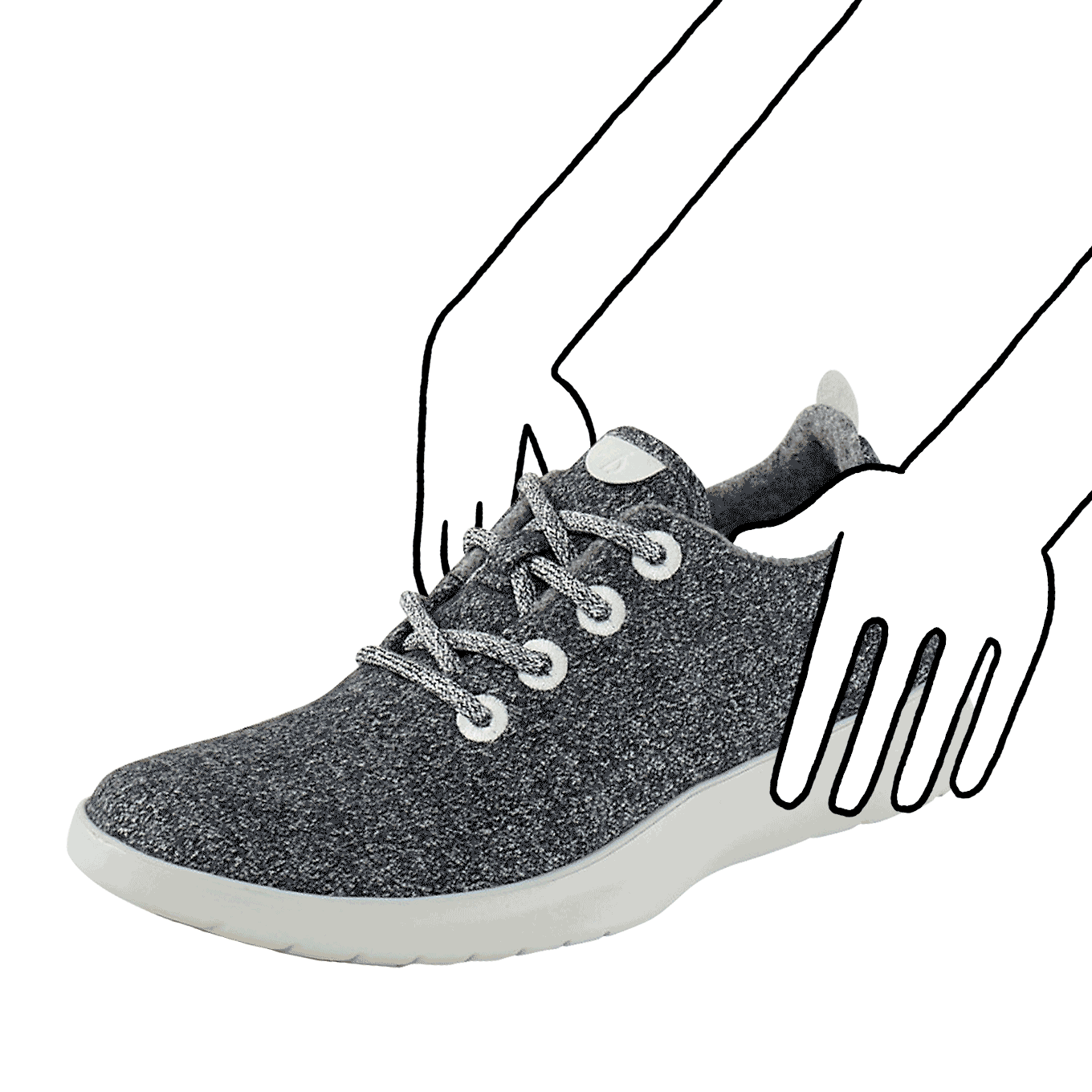
Ecommerce strategy: run creative ads like Allbirds
If you’re an avid Facebook or Instagram user, you’ve probably seen them all over the feeds.
They’re a perfect example of using a creative and clean format to push their ads all over social media.
Select Your Paid Media Advertising Channels
If you want to get the best results from your ecommerce strategies and increase ROI for ecommerce, the following are some specific paid advertising channels and how to use them:
- Display — One of the main types of paid ads you can use to boost ROI in ecommerce marketing is display advertising. These ads appear on websites in the form of images or other media to grab people’s attention. They tend to appear in various places on websites
- Search — These are ads that appear in search results when people look for specific products or other offerings. They can be text-only or include images to connect with audiences and entice them to make a purchase, supplementing display ads in other places across the web.
- Native — You could also get native ad placements that match the content around them, such as relevant sponsored ads within news articles. This form of advertising can help you target the right audiences with ads that are highly relevant to the content they consume.
- Social Media — Want to reach people on Facebook and other social media networks? In these instances, you would use social media advertising, which can work well with display, search, and native ads on other platforms. These ads could include everything from image ads on people’s dashboards to video ads within people’s feeds or in other video content that people view.
- YouTube — If you want to use video advertising to your advantage, YouTube is the leading video streaming platform and offers great placement for ads. Ads typically play before a video starts or somewhere throughout in designated ad breaks.
Ecommerce Strategy #5: Create a Series of Offers and Promote Them With Sumo
If you’re not familiar with Sumo, it’s time you two were introduced.
Sumo is a pop-up conversion optimization tool that is perfect for your ecommerce strategy. With it, you can capture email addresses and run pop ups on your site, targeting people by URL, page, device, referral site.

Sumo Email Capture
So for example, I could choose to run a tailored pop up to users who come specifically from Facebook.
It’s a super sophisticated, very cool tool that I highly recommend you take a look at if you haven’t already.
Use it in conjunction with your content marketing to push users through to your product pages, or as a way to collect email addresses based on specific interests and send them relevant, personalized emails.
And – especially around the holidays – you can use Sumo to add in features like a countdown timer to your pop-up.
Countdown timers, as I’m sure you’re aware, are an easy and awesome way to create a little urgency for your buyers and boost your ecommerce ROI.

Eommerce strategy: use a countdown timer
So if the holidays are approaching, create an offer for a special discount – but include a timer with it so your customers know the clock on that offer is ticking.
Or, use it to run pop-ups for segments of your websites.
Take shoes, for example. You can create a special offer just for the shoes you sell and use Sumo to run pop-ups advertising the discount. So when someone visits the shoe segment of your site, they see the pop-up and will be enticed to make a purchase.
But here’s the deal: if you do run a pop-up, your real goal is to direct users into a specific funnel in your ecommerce strategy.
Always think about the pop-up and the messaging you plan to run, and make sure it aligns with the funnel you want your users kicked into.
If I’m running a pop-up on my blog post on the 10 Best Nike Running Shoes of 2023 for women, I want to make sure that pop up directs them to Nike shoes category of my site and gives them a coupon.
So remember: pre-pop-up, have a goal in mind. Then, create a message and creative offer that will help accomplish that goal.
Ecommerce Strategy #6: Get a Little Crazy With CRO
For anyone new to ecommerce strategies and optimization for ecommerce ROI, CRO stands for conversion rate optimization.
And when it comes to ecommerce strategies, there are plenty of little tweaks you can make to increase your conversions.
Take, for example, the bell icon.
You’ll see it on plenty of major websites like Expedia and Facebook, and what it does is send personalized messages to the user.
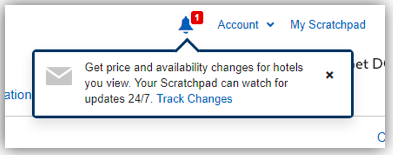
Ecommerce strategy: use a bell icon to increase conversions
I recommend you use one on your site to push any sales or promotions you’re running. That way, when a user navigates to your site they’ll have an alert waiting for them.
You’ll be surprised how effective that little strategy can be.
It’s basic human psychology that we all want what we can’t have, and it makes for a highly effective marketing tactic to incorporate into your ecommerce strategy.
If you can make your users think they might miss out on your product entirely, they’ll be far more likely to pull the trigger.
Take a page out of Expedia’s book: they’re the king of letting users know there’s only x amount of rooms left at the hotel they’re looking at, or that 200 people are also looking at the same room.
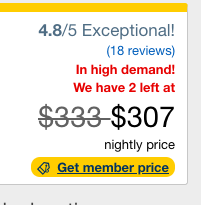
Ecommerce strategy: use scarcity like Expedia
Users get nervous thinking the room might vanish, so they book it. Tada – the scarcity principle at work.
And you can absolutely use it on your own ecommerce site. Try creating a pop up for a product page that says “45 people have bought this product this week!“ “Only 3 units left!” or “99 people are viewing this product right now!”
You can also increase ecommerce ROI by optimizing and testing the following key elements of CRO as you work to connect with and convert new customers:
- Improve the Checkout Process — Shopping cart abandonment remains a big issue for ecommerce websites, with most seeing an average abandonment rate of 65.23%, but you can reduce this rate significantly by optimizing the checkout process. Keep the process simple and don’t make the process too confusing or daunting, with compelling offers that will excite your customers.
- Offer Chat Support — Give your customers the ability to speak with someone if they have any questions or concerns. This goes a long way in providing top-tier customer service that boosts conversions.
- Test CTAs — Make sure your calls to action work by testing them with different messaging and visuals, which can help you determine which drives the best performance.
- Add Social Proof — Include testimonials and reviews in your content, indicating that people are satisfied with your offerings and encouraging new customers to buy from you.
Ecommerce Strategy #7: Ramp Up Your SEO
If you really want to see the best results going into the holidays or launching a new ecommerce campaign, you need an ecommerce strategy to really ramp up your SEO for ecommerce going into it.
Not to worry; I have a full set of guidelines for you here:
Start 3 Months Before Your Big Sale
Make sure you get a head start on your ecommerce SEO and begin developing your strategy months before your sale.
Optimize Top Sellers
Determine your top revenue drivers and align with inventory – so you would take the products that make you the most money, say it’s a surfboard, and make sure you have enough inventory to fulfill all incoming orders.
Refresh Your Pages
Refresh your top pages every two weeks, including the product pages that get the most traffic – this will help your content continuously rank higher in the search engines. Try to create a system and schedule of adding:
- Facts
- FAQs
- New copy, including new relevant keywords
Create Content Hubs
Build hubs of content – this one’s all about quality. The higher the quality of your content, the higher it will rank, and the more people will come back to your site. Ultimately, you want to be a hub for any and all content related to the products you sell.
Develop Your Internal and External Linking Strategies
Build multiple links to important pages each month, including internal links on your own site to various product pages and others, along with backlinks from other reputable sites.
Use Promotions and PR
Send out a series of press releases and promote categories and products on your website, social media, and other platforms.
Harness the Power of Sponsored Posts
Sponsored posts help – head back to strategy #4 for a refresher on how you can use sponsored posts to boost ecommerce ROI.
Showcase Your Top-Priority Pages
Promote your important URLs and drive social traffic to them, which can help supplement other ecommerce SEO efforts for each page.
Bonus tip: treat your new campaign like a product launch to boost ecommerce ROI.
All rules apply. If you’re not familiar with them, I have a complete guide here to all the pre, during, and post-launch steps you’ll want to cover.
By regularly tracking your SEO campaigns and reviewing SEO reports, you can ensure you’re getting the results you want from these efforts.
Ecommerce Strategy #8: Run an Email Marketing Campaign
Another strategy to implement for boosting ecommerce ROI involves email marketing.
Email remains one of the best tools to use for ecommerce sites, with the average email ROI in ecommerce marketing coming to about $45 for every dollar spent on these campaigns.
The following are a couple of key steps to take if you want to get the most from email marketing efforts:
Build an Email List
You can build your email list in various ways if you want to add people as contacts when attempting to boost conversions and sales.
For instance, you can:
- Give people a compelling offer that encourages email signups
- Use an effective CTA
- Place your signup forms in the right places, such as headers, footers, and blog homepages, along with product pages
Segment Your Audience for Better Targeting
After building your email list, you can hyper-target your email campaigns by segmenting your audiences.
You can segment them based on various elements, including demographics like age and location, behavioral data, and purchase history.
Based on each segment, you can optimize email content to build solid connections with all recipients in your list.
Ecommerce Strategies FAQs
1. How can I make my product photos more enticing?
Photos are crucial to your ecommerce strategy being a success. You need to make sure that you are uploading high-quality, clear images that showcase the best angles of your products.
If you are not skilled in photography, you should hire a professional photographer to get the best results. Be sure to ask for multiple angles.
Your website should also over the Zoom-In feature so that visitors can take a closer look at your products before they buy.
3D images are another way to spice things up. A 3D representation of your products will boost engagement rates and conversion rates.
2. Should I include videos?
Yes.
A recent study showed that 70% of consumers are more confident with their online purchases after watching a video about the products they are looking at.
Videos are a great addition to your ecommerce strategy because they show your customers what to expect from the products they are ordering.
3. Should I invest in a chatbot?
Yes.
Chatbots go a long way with customer service and turn a hesitant consumer into a confident buyer.
A live chatbot will add that personalization factor that I talked about earlier. It’s a great ecommerce strategy to incorporate into your website.
4. How do I choose the right influencer for my brand?
You can choose the best influencer to help increase ecommerce ROI by taking the right approach.
As you search for the ideal influencer, look for one based on a shared audience and your particular niche. You can also reach out and find out how much the influencer will charge to work with you.
Keep in mind that even micro-influencers with a very niche focus and small audiences can get great results, seeing as many of these influencers still have a loyal following that can be relevant to your niche.
5. What are the best tools to measure the success of my ecommerce strategies?
There are plenty of tools out there for you to use to monitor and optimize your ecommerce marketing efforts. The following are a few worth trying:
- Google Analytics for KPI tracking
- Omnisend for email marketing and website behavior tracking
- Shopify Analytics for keeping track of Shopify store performance
6. How can I integrate AI and machine learning into my ecommerce strategies?
You can integrate powerful AI and machine learning technologies into your ecommerce marketing strategies in different ways.
For instance, you can use AI tools and machine learning to collect all types of data about customers, which can give you invaluable insights into their behavior and demographic information.
Using this information, you can use other AI tools to develop and push personalized content that resonates with new and existing customers.
7. Why should I prioritize mobile optimization for my ecommerce site?
More and more people are using mobile devices to shop online and do research when not shopping.
If your ecommerce website doesn’t work for or appeal to mobile users, you’ll alienate a huge section of your audience.
Make sure your ecommerce site is mobile-responsive and well-optimized for mobile search to ensure mobile users find you and enjoy a great customer experience.
Wrapping Up Ecommerce Strategies
There you have it: 8 ecommerce strategies that will skyrocket your sales. Whether you’re looking to connect with your customers, create a better brand experience, or boost your online reviews, we’ve got you covered.
Ignite Visibility has helped hundreds of businesses:
- Set up personalized messaging
- Build advanced targeting strategies
- Start and grow integrated paid media plans
- Ramp up your SEO and CRO
Let us help you launch and scale your ecommerce marketing today. Contact us now!